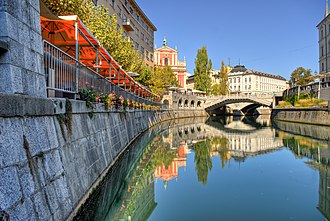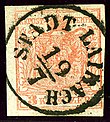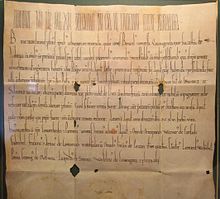Ljubljana
![]()
Aemona is a redirect to this article. A titular bishopric of the Roman Catholic Church is also called Aemona; see titular bishopric of Aemona.
(![]() Slovenian [ljuˈbljàːna], colloquially [luˈblàːna]; German Laibach; Italian Lubiana) is the capital of Slovenia and also its largest city, with 284,355 inhabitants (2019).
Slovenian [ljuˈbljàːna], colloquially [luˈblàːna]; German Laibach; Italian Lubiana) is the capital of Slovenia and also its largest city, with 284,355 inhabitants (2019).
The city is the political, economic and cultural centre of Slovenia. Ljubljana is the seat of the Roman Catholic archbishopric of the same name and has been a university city since 1919.

View from the castle to the city

The central promenade runs along the Ljubljanica River, which is crossed by more than a dozen bridges.
City name
There are several explanations for the origin of the Slovenian name of the town: according to one, probably folk etymological explanation, it comes from the Slovenian ljubljena ("beloved town"), according to the other from the Latin river name Aluviana. The town name was first mentioned in this form in 1146 as Luwigana.
In German-speaking countries, in addition to the name Ljubljana, the historical German name Ljubljana, originally probably derived from Slavic like the river name of the same name, has also survived, and is now used mainly in Austria. In German and Austrian diplomacy, the city is officially called Ljubljana. The German name of the city was first mentioned in 1112-1125 as Leibach. This form is also the oldest known mention of the city.
History
| Political affiliation of Ljubljana since 1144 | ||
| State | Administrative Unit | Affiliation |
| Roman Empire Holy 1400 | Margraviate of Carniola | 1144–1364 |
| Duchy of Carniola | 1364–1804 | |
| Austria Empire | Duchy of Carniola | 1804–1809 |
| France 1804 | Illyrian provinces | 1809–1813 |
| Austria Empire | Illyrian provinces | 1813–1816 |
| Kingdom of Illyria | 1816–1849 | |
| Duchy of Carniola | 1849–1867 | |
| Austria-Hungary | Duchy of Carniola | 1867–1918 |
| Yugoslavia Kingdom 1918 | Province of Slovenia | 1918–1922 |
| Ljubljana Oblast | 1922–1929 | |
| Drava Bank | 1929–1941 | |
| Italy 1861 | Ljubljana Province | 1941–1943 |
| German Reich NS | Province of Ljubljana formally Italian | 1943–1945 |
| Yugoslavia Socialist Federal Republic of | People's Republic of Slovenia | 1945–1963 |
| Socialist. Rep. Slovenia | 1963–1990 | |
| Republic of Slovenia | 1990–1991 | |
| Slovenia | Municipality of Ljubljana | since 1991 |
Previous story
From 3600 to 3100 B.C. the earliest lake dwellings (lake dwellings) are found in the Laibacher Moor.
Between 1000 and 700 BC the first Illyrian and Venetian settlements existed and around 400 BC the period of the Celts followed.
The first mythical inhabitant is considered to be Jason (see the section on coats of arms).
Roman Empire
In the 1st century BC, the Romans built a military fortress on the site of today's Ljubljana, and in 14 they established the Roman settlement of Emona or Aemona (Colonia Aemona Iulia tribu Claudia). Although it was located on the site of today's Ljubljana, it perished in the Migration Period and is therefore only a predecessor settlement of today's city.
Migration and Frankish Empire
Around 600 Slavic tribes migrated to the area, followed by Emona's decline. Around 800 the area of Ljubljana fell under the rule of the Franks.
Holy Roman Empire
The city before the 13th century
In the East Frankish and later Holy Roman Empire, the area around Ljubljana belonged to the Margraviate of Carniola. The period between 1112 and 1125 is the date of the first written records of Ljubljana. The first written record of the city dates back to 1144. The settlement founded by the Spaniards was first called a city around 1220, in 1243 its market rights and city walls are on record, and in 1280 the inhabitants were called "cives" (citizens).
In 1270 Ljubljana was conquered by the Bohemian king Premysl Ottokar II, who had previously subjugated the Austrian dominion of the Babenbergs after their extinction in 1246.
Habsburg rule, Reformation and Counter-Reformation
In 1278 Ljubljana became the property of the Habsburgs after the defeat of King Ottokar II by Rudolf of Habsburg.
In 1335, under the Habsburgs, Ljubljana became the capital of the Duchy of Carniola, which was part of the Holy Roman Empire. In 1415 Ljubljana resisted a Turkish invasion.
In 1461 the Diocese of Ljubljana was founded (see also: List of Bishops of Ljubljana), and the Church of St. Nicholas became the Cathedral. In 1504 the election of the first mayor took place. In 1511 Ljubljana experienced its first major earthquake.
The first Reformation sermon was preached in 1523 at the latest. Supported by the Krainer Landstände, Protestants established a professional Latin school in the rank of a grammar school in 1536. Besides humanism, the Slovenian reformer Primož Trubar (Primus Truber, 1508-1586) had a formative influence on the development of the Reformation through his sermons in Slovenian. With his extensive written works in Slovenian, he is considered the founder of the Slovenian written language. In 2016, Ljubljana was awarded the honorary title of "Reformation City of Europe" by the Community of Protestant Churches in Europe.
After the Jesuits arrived in Ljubljana in 1597 and established their own grammar school two years later, the Trubar Reformation in Slovenia came to an end in the first third of the 17th century. With the Counter-Reformation, the church and school ministry in Ljubljana was closed, Protestant preachers were expelled, a religious reformation commission was established, and the nobility who were unwilling to convert were expelled from the country. New congregations were founded in Ljubljana in the middle of the 19th century - made possible by the Josephine Tolerance Patent of 1781; the Slovenian Church of the Augsburg Confession has existed since 1945.
In 1693 the Academia Operosum, an association of the most distinguished scholars, was founded, and in 1701 the Academia Philharmonicorum.
In 1754 the population was 9,300 inhabitants. From 1773 to 1781, the Gruber Canal (Gruberjev kanal) and the Gruber Palace (Gruberjeva palača) were built. In 1797 the first daily newspaper of Slovenia was published.
Austrian Empire
In 1804 Ljubljana became part of the newly proclaimed Empire of Austria. After the Peace of Schönbrunn, the city and the surrounding countryside had to be ceded to Napoleonic France, and the city became the capital of the Illyrian Provinces of France under the name Laybach from 1809 to 1813. In 1814/15 it returned to Austria with the Congress of Vienna.
In 1810 the botanical garden was founded. In 1821, at the invitation of Emperor Franz I, the Ljubljana Congress of the Holy Alliance took place.
In 1849 the railway connection Ljubljana-Vienna, the Austrian Southern Railway, was built and in 1857 as an extension the connection Ljubljana-Trieste.
In 1861 public gas lighting was introduced and in 1890 the public water supply was built. After a devastating earthquake, Ljubljana committed itself to a modern appearance in 1895. In 1898, public electric lighting was introduced. Three years later, in 1901, followed the introduction of the electric tram in Ljubljana.
In 1900 Ljubljana had 36,547 inhabitants including the garrison. Of these, 29,733 were Slovene-speaking (81%) and 5423 German-speaking (15%).
Before the First World War, Ljubljana was an Austro-Hungarian garrison town. In 1914, the following were stationed here in whole or in part: the staff of the k. u. k. 28th Infantry Troops Division, the k.u.k. Krainerische Infanterie Regiment No. 17, the k.u.k. Styrian Infantry Regiment No. 27, the k.u.k. Landwehr Infantry Regiment No. 27 and the k.u.k. Feldkanonen Regiment Nr. 7. The strategic decisions for the Italian front, especially for the Isonzo Front, were made by the army command in Ljubljana, where Field Marshal Boroević and the later Austrian Federal President Körner, among others, were active.
Kingdom of Serbs, Croats and Slovenes and Kingdom of Yugoslavia
At the end of October 1918, Ljubljana became part of the newly founded Kingdom of Serbs, Croats and Slovenes. In 1919, the University of Ljubljana was founded. In 1929, Ljubljana became the capital of the Drava Banja (Dravska banovina) in the Kingdom of Yugoslavia.
Italian annexation and German occupation
After the invasion of Yugoslavia in World War II, Ljubljana became the capital of the annexed Italian Provincia di Lubiana on 3 May 1941, with the former Yugoslav general Leon Rupnik as mayor, under the name Lubiana. The majority of the Ljubljana Germans, about 2400, were resettled in the winter of 1941/42 on the basis of an agreement between Adolf Hitler and Benito Mussolini to the Greater German Reich, the majority to Upper Carniola and Lower Styria.
In 1942, Italian troops sealed off the town with a barbed wire fence and watchtowers and thereafter combed it several times as part of the Italian repression against the Slovene resistance. By the time of Italy's surrender in September 1943, about eighteen percent of Lubiana's population had been deported to Italian concentration camps.
After Italy's surrender, it passed into German control (SS General Erwin Rösener and Friedrich Rainer as head of the civil administration) until the complete surrender of the Wehrmacht on 8 May 1945.
Socialist Federal Republic of Yugoslavia
On 9 May 1945, the Provincia di Lubiana was formally dissolved. In 1945, the remaining Laibach Germans, like the other Slovene Germans, had to leave the country on the basis of the AVNOJ decisions. Numerous people were murdered.
In 1945 Ljubljana became the capital of the People's Republic of Slovenia in the Federative People's Republic of Yugoslavia.
In 1958 the first Slovenian television station started regular broadcasts and in that year the tramway was closed down. In 1980, Yugoslav President Josip Broz Tito died in Ljubljana.
Republic of Slovenia
In 1991 the city celebrated Slovenia's independence.
In 2002, the Bush/Putin summit took place in Ljubljana.
Only a few weeks after the discovery of a new mass grave with more than 4,000 people murdered by Tito partisans in a Slovenian mine, the city council of Ljubljana decided with the majority of the left-wing parties in April 2009 to name a street after Josip Broz Tito again, after the current Slovenska cesta (Slovenian Street) had already been named after him until 1991.

Stamp of the Austrian coat of arms issue 1850 with postmark of Ljubljana

Slovenian Philharmonic Orchestra, founded in 1701

In this document of the Patriarch of Aquileia of 1146 appears a "Wodolricus de Luwigana", with which the name of the later town is mentioned for the first time.
Questions and Answers
Q: Where is Ljubljana located?
A: Ljubljana is the capital city of Slovenia.
Q: How large is Ljubljana compared to other cities in Slovenia?
A: Ljubljana is the largest city in Slovenia.
Q: When did Ljubljana become the most important settlement in the area?
A: Ljubljana became the most important settlement in the area when Romans ruled Slovenia.
Q: Are there any museums with exhibits from ancient times in Ljubljana?
A: Yes, there are many museums with things from that time in Ljubljana.
Q: How many people lived in Ljubljana as of 2002?
A: As of 2002, there were 265,881 people living in Ljubljana.
Q: Is there a university in Ljubljana?
A: Yes, the University of Ljubljana is located in Ljubljana.
Q: What is the significance of Ljubljana being the capital city of Slovenia?
A: As the capital city of Slovenia, Ljubljana serves as the political, economic, and cultural center of the country.
Search within the encyclopedia